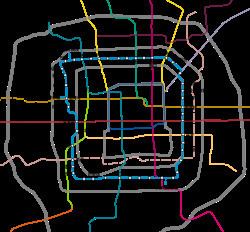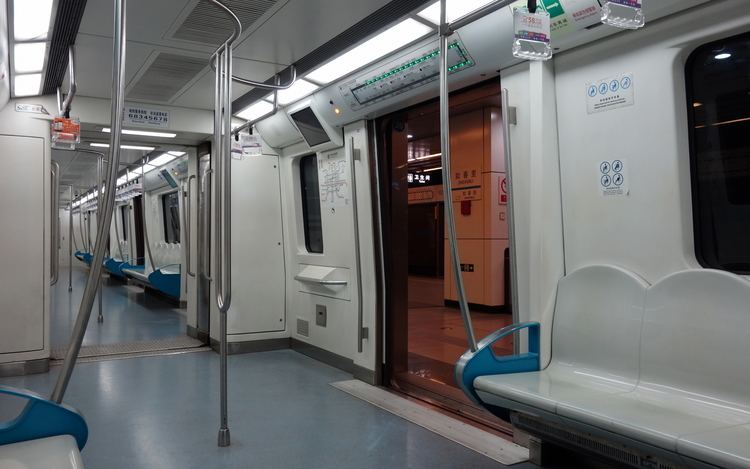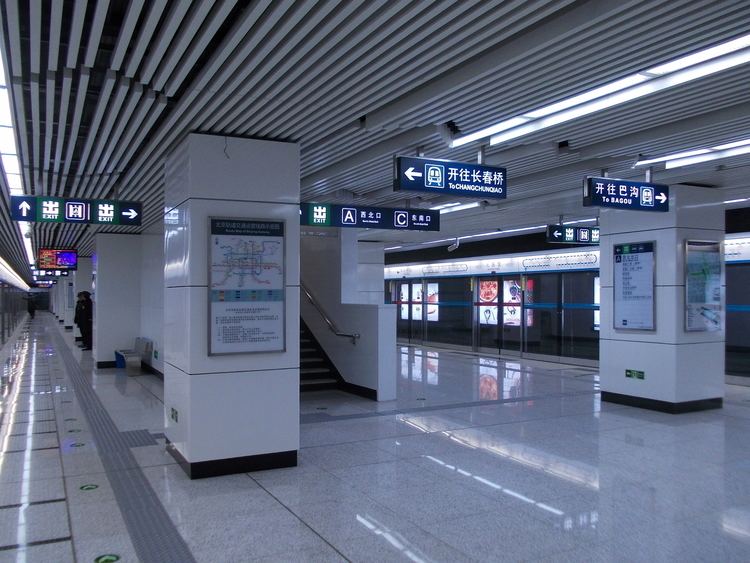Type Rapid transit Status Operational | System Beijing Subway Stations 45 | |
 | ||
Daily ridership 1,690,100 (2014 Avg.)
2,076,500 (2014 Peak) Opened 19 July 2008 (Phase I)
30 December 2012 (Phase II, minus three stations)
5 May 2013 (remainder of Phase II) Operator(s) Beijing Mass Transit Railway Operation Corp., Ltd | ||
Line 10 of the Beijing Subway (Chinese: 北京地铁10号线; pinyin: běijīng dìtiě shíhào xiàn) is the second loop line in Beijing's rapid transit network as well as the longest and most widely used line. The line is 57.1 km in length and runs entirely underground through Haidian, Chaoyang and Fengtai Districts, either directly underneath or just beyond the 3rd Ring Road. The Line 10 loop is situated between two and six kilometers outside of the Line 2 loop, which circumnavigates Beijing's old city. Every subway line through the city centre intersects with Line 10, which has 24 (currently 14 available) transfer stations along route, and 45 stations in all. Line 10's color is Capri.
Contents
- Planning
- Phase I
- Phase II
- Fare
- Hours of Operation
- Route
- Service routes
- Rolling stock
- Signaling system
- Safety
- References

Line 10 is the world's longest subway loop line and one of the longest entirely underground subway lines requiring 104 minutes to complete one loop. It is also the longest line to use Siemens' Communication Based Train Control (CBTC) system.

Planning

The Beijing Subway network was originally conceived to have only one ring line. The booming economy and explosive population growth of Beijing has put a huge amount of demand on Line 2, surpassing its designed capacity. In 2001 and 2002, the China Academy of Urban Planning and Design proposed that two "L-shaped" lines named Line 10 and 11. Together they will form a second loop around Beijing and relieve traffic demand on line 2.
Phase I

On December 27, 2003, in preparation of the 2008 Summer Olympic Games in Beijing, Phase 1 of Line 10 started construction. On July 19, 2008, Phase I of Line 10 entered operation ahead of the opening of the Olympic Games. It was 24.68 km in length and had 22 stations. Phase I consisted of the northern and eastern sides of Line 10's rectangular loop from Bagou to Jinsong forming an inverted "L"-shaped line.
Phase II

Construction on Phase II began on December 28, 2007. which means the original plan of Line 11 was not incorporated into the final network design and was absorbed into the Line 10. Line 10 formed the second full loop around Beijing. In 2010, the Ministry of Railways proposed that Fengtai Railway Station is to be renovated and expanded to become a bigger intercity rail terminal for Beijing, with access to the Beijing-Guangzhou high-speed railway. The rational was to ease intercity traffic pressure on Beijing West Railway Station. Due to the need to reorganize the stations on Line 10 to better serve the new rail terminal, work stopped on 2 stations, namely Mengjiacun (孟家村) and Niwa (泥洼). The planning department proposed that the original Mengjiacun and Niwa subway stations be merged into the new Fengtai Railway Station, known as the "three stops into one" program. Local residents, after realizing their travel to a subway station would be greatly lengthened, quickly opposed the plan. Planners reconsidered and moved Niwa Station 300m north to its current position and Mengjiacun 100m north to be renamed as Fengtai Railway Station. The original station shells were demolished and new stations built in their respective new locations. Niwa station started reconstruction in February 2012, while Fengtai Railway Station started on April 11, 2012. This made the late 2012 opening date for that section of Line 10 highly unlikely and was postponed to the next year. On December 30, 2012, the first section of Phase II, consisting of the southern and western sides of the loop opened. With the opening of Phase I and Phase II, Line 10 became a "C" shape.

With the opening, the rapid growth in Line 10's ridership, coupled with the fact that Line 6 relieved some traffic from Line 1, allowed Line 10 to overtake line 1 as Beijing's busiest subway line. The Beijing subway started operating express trains that ran non-stop between Songjiazhuang to Jinsong to alleviate traffic in the southeastern section of Line 10. These trains stopped operation after the completion of the loop.
The loop was fully enclosed on May 5, 2013 with the opening of Niwa, Jiaomen East, and Fengtai Railway Stations. Service on the Line 10 now consists of "full-loop" trains that make the journey through all 45 stations in 104 minutes, and "partial-loop" trains that run from Chedaogou in the northwest to Songjiazhuang in the southeast before turning back.
Fare
Starting fare of RMB(¥) 3.00 that increases according to the distance fare scheme introduced in December 2014.
Hours of Operation
The first train on the inner (clockwise) loop departs from Xiju towards Shoujingmao at 5:20am. The first train on the outer (counter-clockwise) loop departs from Shoujingmao towards Xiju at 6:12am. The last inner loop train leaves Xiju for Bagou at 11:29pm. The last outer loop train leaves Shoujingmao for Chedaogou at 11:06pm. For the official timetable, see.
Route
From Bagou near Wanliu Park in Haidian District, Line 10 runs straight east, between the northern 3rd and 4th Ring Roads. At Xitucheng, the line meets the northern section of the Yuan dynasty earthen city wall, called tucheng. The Jiandemen and Anzhenmen stops are named after former gates in the wall. At Beitucheng, Olympic Branch Line extends off Line 10 and provides access to the Beijing Olympic Green. Farther east, Line 10 turns south after the Sanyuanqiao and follows the eastern 3rd Ring Road straight south to Jinsong in Chaoyang District. The Bagou-Jinsong section constituted Phase I of Line 10, which first opened in July 2008, and connects the university district in Haidian with the embassy district and Beijing CBD. A trip from Bagou to Jinsong takes about 40 minutes.
Service routes
Rolling stock
Line 10 utilizes a fleet of 6-car DKZ15 trains manufactured by Changchun Railway Vehicles. Initially when Phase I opened the line was operated with a fleet of only 40 trainsets (240 cars). Some sets operated on the Olympic section of Line 8 before Line 8 was extended and acquired its own dedicated rolling stock. When Line 10 Phase II opened the fleet was expanded to 84 trains. However the two existing depots serving Line 10 had insufficient capacity for the entire fleet. Therefore, only 76 trainsets could operate on the line with 8 being temporary stored in other Beijing Subway depots. With the opening of the new depot in Songjiazhuang and the need to reduce the headway on line to decrease crowding, an additional 32 trainsets have been ordered. The fleet will grow to 116 trainsets allowing Line 10 to operate at a headway of every 2 minutes throughout the line during rush hour.
Signaling system
For metro line 10, Siemens Transportation Systems and China Railway Signaling & Communication Corp. have equipped the line with ETCS Level 3 technology. As a fallback level the ETCS Level 1 is available.
Safety
There are subway public security bureaus (police stations) located in the Bagou, Beitucheng and Liangmaqiao stations. Emergencies can be reported by calling 110 or 64011327.
